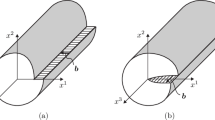Abstract
Since line defects (dislocations) and point defects (vacancies, self-interstitials, point stacking faults) in Bravais crystals can mutually convert, only theories which comprise these two sorts of defects can be closed in the sense of general field theory. Since the pioneering work of Kondo and of Bilby, Bullough, and Smith it is clear that differential geometry is the appropriate mathematical tool to formulate a field theory of defects in ordered structures. This is done here on the example of the Bravais crystal, where the above-mentioned defects are the only elementary point and line defects. It is shown that point defects can be described by a step-counting procedure which makes it possible to include also point stacking faults as elementary point defects. The results comprise two equations with the appropriate interpretation of the mathematical symbols. The point defects are step-counting defects and are essentially described by a metric tensorg, which supplements the torsion∑ responsible for the dislocations. The proposed theory is meant to form a framework for defect phenomena, in a similar way that Maxwell's theory is a framework for the electromagnetic world.
Similar content being viewed by others
References
Anthony, K.-H., and Knoppe, H. (1987). Phenomenological thermodynamics of irreversible processes and Lagrange-formalism-hyperbolic equations for heat transport, inKinetic Theory and Extended Thermodynamics, I. Müller and T. Ruggeri, eds., Pitagora Editrice Bologna, Italy, pp. 15–30.
Bilby, B. A., Bullough, R., and Smith, E. (1955). Continuous distributions of dislocations: a new application of the methods of non-Riemannian geometry,Proceedings of the Royal Society A,231, 263–273.
Dehlinger, U. (1929). Zur Rekristallisation reiner Metalle,Annalen der Physik V. Folge,2, 749–793.
Diehl, J. (1965). Atomare Fehlstellen und Strahlenschädigung, inModerne Probleme der Metallphysik, A. Seeger, ed., Springer, Heidelberg, pp. 277–329.
Edelen, D. G. B., and Lagoudas, D. C. (1988). Gauge theory and defects in solids, InMechanics and Physics of Discrete Systems, Vol. 1, G. C. Sih, ed., North-Holland, Amsterdam.
Friedel, J. (1967).Dislocations, Pergamon Press, Oxford.
Heidenreich, R. D., and Shockley, W. (1948). InReport Conference on the Strength of Solids, The Physical Society, London, p. 57.
Kadic, A., and Edelen, D. G. B. (1983).A Gauge Theory of Dislocations and Disclinations, Springer, Heidelberg, Germany.
Kléman, M. (1981). Crystallography of amorphous bodies, inContinuum Models of Discrete Systems 4, O. Brulin and R. K. T. Hsieh, eds., North-Holland, Amsterdam, pp. 287–296.
Kondo, K. (1952). On the geometrical and physical foundations of the theory of yielding, InProceedings 2nd National Congress on Applied Mechanics, Tokyo, pp. 41–47.
Kröner, E. (1981). Continuum theory of defects, inPhysics of Defects (Les Houches, Session 35), R. Balianet al., eds., North-Holland, Amsterdam, pp. 215–315.
Kröner, E. (1986). The continuized crystal—A bridge between micro- and macromechanics?Zeitschrift für Angewandte Mathematik und Mechanik,66, T284-T292.
Kröner, E. (In press). Point defects and metricity, inInelastic Solids and Structures, M. Kleiber and J. A. König, eds., Pineridge Press, Swansea.
Kunin, I. A., and Kunin, B. I. (1986). Gauge theories in mechanics, inTrends in Applications of Pure Mathematics to Mechanics, Springer, Heidelberg, Germany, pp. 245–269.
Schouten, J. A. (1954).Ricci-Calculus, Heidelberg, Germany.
Seeger, A. (1955). Theorie der Gitterfehlstellen, InEncyclopedia of Physics, S. Flügge, ed., Springer, Heidelberg, Germany, pp. 383–665.
Turski, Ł. (1986). Variational principle for equilibrium and incompatibility equations in dislocation theory,Bulletin of the Polish Academy of Sciences, Technical Sciences,14, 289–294.
Author information
Authors and Affiliations
Rights and permissions
About this article
Cite this article
Kröner, E. The differential geometry of elementary point and line defects in Bravais crystals. Int J Theor Phys 29, 1219–1237 (1990). https://doi.org/10.1007/BF00672933
Received:
Issue Date:
DOI: https://doi.org/10.1007/BF00672933




